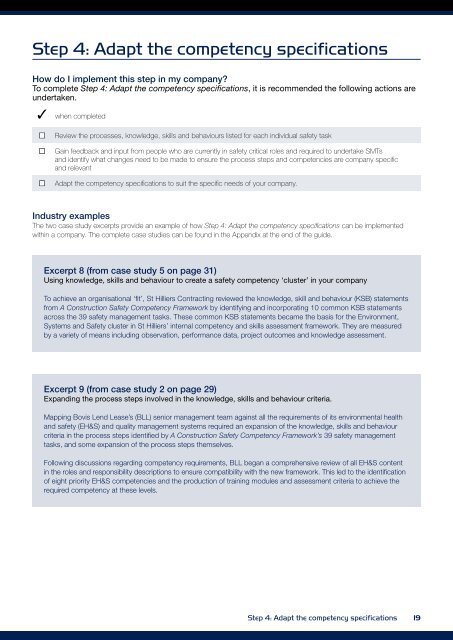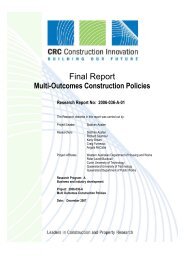A Practical Guide to Safety Leadership Book (PDF 5MB) - QUT ePrints
A Practical Guide to Safety Leadership Book (PDF 5MB) - QUT ePrints
A Practical Guide to Safety Leadership Book (PDF 5MB) - QUT ePrints
You also want an ePaper? Increase the reach of your titles
YUMPU automatically turns print PDFs into web optimized ePapers that Google loves.
Step 4: Adapt the competency specifications<br />
How do I implement this step in my company?<br />
To complete Step 4: Adapt the competency specifications, it is recommended the following actions are<br />
undertaken.<br />
when completed<br />
■<br />
■<br />
■<br />
Review the processes, knowledge, skills and behaviours listed for each individual safety task<br />
Gain feedback and input from people who are currently in safety critical roles and required <strong>to</strong> undertake SMTs<br />
and identify what changes need <strong>to</strong> be made <strong>to</strong> ensure the process steps and competencies are company specific<br />
and relevant<br />
Adapt the competency specifications <strong>to</strong> suit the specific needs of your company.<br />
Industry examples<br />
The two case study excerpts provide an example of how Step 4: Adapt the competency specifications can be implemented<br />
within a company. The complete case studies can be found in the Appendix at the end of the guide.<br />
Excerpt 8 (from case study 5 on page 31)<br />
Using knowledge, skills and behaviour <strong>to</strong> create a safety competency ‘cluster’ in your company<br />
To achieve an organisational ‘fit’, St Hilliers Contracting reviewed the knowledge, skill and behaviour (KSB) statements<br />
from A Construction <strong>Safety</strong> Competency Framework by identifying and incorporating 10 common KSB statements<br />
across the 39 safety management tasks. These common KSB statements became the basis for the Environment,<br />
Systems and <strong>Safety</strong> cluster in St Hilliers’ internal competency and skills assessment framework. They are measured<br />
by a variety of means including observation, performance data, project outcomes and knowledge assessment.<br />
Excerpt 9 (from case study 2 on page 29)<br />
Expanding the process steps involved in the knowledge, skills and behaviour criteria.<br />
Mapping Bovis Lend Lease’s (BLL) senior management team against all the requirements of its environmental health<br />
and safety (EH&S) and quality management systems required an expansion of the knowledge, skills and behaviour<br />
criteria in the process steps identified by A Construction <strong>Safety</strong> Competency Framework’s 39 safety management<br />
tasks, and some expansion of the process steps themselves.<br />
Following discussions regarding competency requirements, BLL began a comprehensive review of all EH&S content<br />
in the roles and responsibility descriptions <strong>to</strong> ensure compatibility with the new framework. This led <strong>to</strong> the identification<br />
of eight priority EH&S competencies and the production of training modules and assessment criteria <strong>to</strong> achieve the<br />
required competency at these levels.<br />
Step 4: Adapt the competency specifications 19

















